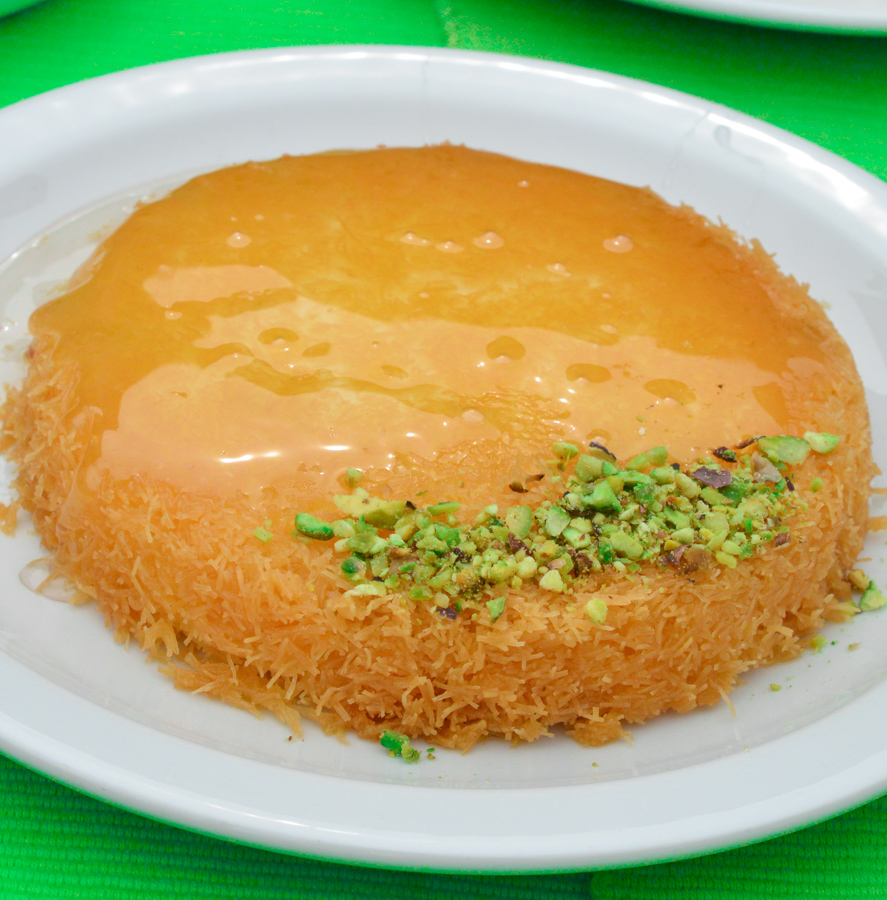
Knafeh Bil Ashta
Knafeh Bil Ashta: This scrumptious dessert has everything you expect from a Middle Eastern sweet. Two layers of kadaifi dough (shredded phyllo dough), infused with ghee, sandwiched with a layer of ashta (Middle Eastern version of clotted cream), baked and saturated with fragrant orange blossom water syrup. Yes, no cheese is involved in this version!
I will always have a soft spot in my heart for Middle Eastern desserts that rely on sugar syrup rather than granulated sugar as a sweetener, and the queen of those sugar syrup-soaked desserts is sure to be knafeh (pronouncing it depends on where you live and what country of origin you come from, knafeh, kunafa, knafa, kunafah, and maybe more. it is the epitome of deliciousness and a standard among Middle Eastern cooks with many variations. The next time you’re looking for a sweet end to a Middle Eastern-inspired meal, make this version, it tastes divine!
The taste of the orange blossom water scented sugar syrup shines through beautifully here, and its flavor is lovely with the ashta (cream filling) and the roasted kadaifi (knafeh).

Knafeh Bil Ashta sounds like something fancy and complicated, but it’s actually homey and easy to make, though you do have some steps to prepare before putting everything together. For a time saving strategy, prepare the ashta (filling) and Arabic sugar syrup one or two days in advance, refrigerate until you need.
Knafeh/ kunafa Bil Ashta
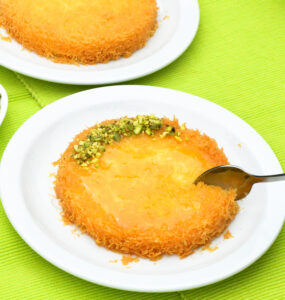
Tips to make a perfect Knefeh Bil Ashta
- A minimal amount of atter (sugar syrup) is drizzled on top, and then upon serving, you can control the amount of extra sugar syrup you spoon onto your knafeh portion.
- Sugar syrup should be cold when drizzeled on the sizzling hot knafeh, it is advisable to prepare the sugar syrup a day or two in advance and refrigerate, and by the way, can be refrigerated for up to 1 month.
- Best eaten while warm, knafeh bil Ashta is ideal to make for company who will devour up on the spot. But also can be refrigerated for up to four to five days and re-warmed in the oven.
- The ashta can be loosely covered and refrigerated for up 3 days.
- The knafeh you find in Lebanese sweet shops is a bit different from what I am showcasing in todays post. It meant to be with a smoother upper crust, knafeh naameh). Will be posting in the coming future a detailed one, but this is equally good, I promise!
- Prepare ahead of time: Easy to prep up to 2 days in advance if you’d like! This is my favorite make-ahead dessert for easy entertaining. But when you add in the extra few minutes to bake just before serving, easy right? And of course, tastes divine! So you can enjoy your meal, then pop in the oven for a quick 15 – 17 minutes then indulge into each sweet bite. Guests have absolutely raved about this dessert.
- The cooled sugar syrup (atter) gets poured over the still-hot pastry so that you hear it sizzle. Classically filled with cheese or ashta (Middle eastern clotted cream).
- I used 6 individual mini round rimmed 12 cm/ 5 inches baking sheets. For those who immediately tune out, rest assured you can assemble in a giant round 30 cm rimmed baking sheet, but please note that it will require more time to bake through.
- If you are using frozen shredded dough/ kadaifi then defrost in the packaging overnight in the refrigerator.
- Very carefully remove the knafeh from the oven, carefully remove the mini baking sheets and transfer. The easiest way to flip your baked knafeh is to cover the baking pan with a pan with a larger baking sheet.
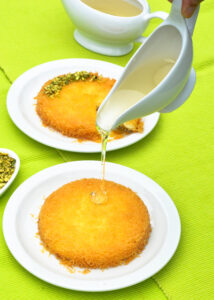
The only substitute for ghee! The grand thing about most Middle Eastern dessrts is that ghee should be used for a rich and luxurious flavor. Whether it’s knafeh, baklava, namoura, and much more ghee is irreplaceable with butter, unless you clarify the butter. You may be asking why? Milk solids in butter may burn the kadaifi. When you clarify butter, you remove all the milk solids and water, then you are left with the butterfat. This creates a higher smoke point, which makes similar to ghee!
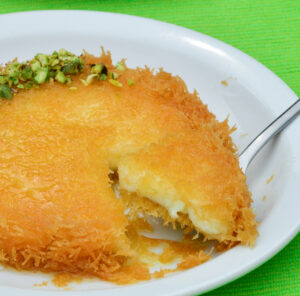
Where to find shredded kunafa /Kadaifi?
In the Middle East, kunafa/ kadifi can easily be purchased fresh which something I prefer to use in this recipe. However, it is still doable with the frozen stuff. You can find it outside the Middle East in the freezer section of Middle Eastern, international and some gourmet markets.
The ideal baking sheet for making knafeh!
After much testing, I found that aluminum baking sheets give the ultimate in heat distribution throughout the whole tin, meaning the kadaifi (shredded phyllo dough) roast evenly due to the high-heat conductivity; this will, eventually, help prevent burnt bits or soggy bottoms! Now take a look the attractive golden color of the crust
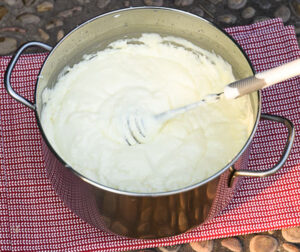
Make the Ashta, (Middle Eastern Clotted Cream)
Place the milk, cornstarch in a saucepan over medium heat, whisking constantly until the mixture boils and thickens. Add the orange blossom water, whisk one more time, and set aside to completely cool down.
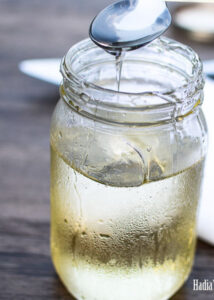
Make the Atter (Sugar Syrup infused with orange blossom water)
Place the sugar, water, and lemon juice in a saucepan over medium heat. Stir the mixture with a wooden spoon to dissolve the sugar. Once it boils reduce heat to low and simmer for 7 minutes. Do not cover the saucepan. Add the orange blossom water and simmer for 1 more minute. Set aside to completely cool down.
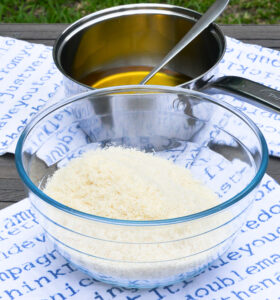
Defrost the shredded filo pastry if frozen. Lightly pull the dough with your hands to separate into a loose pile. Add to a food processor, you may probably need to do that in batches, and pulse a few times to break down the kadaifi as much as possible.
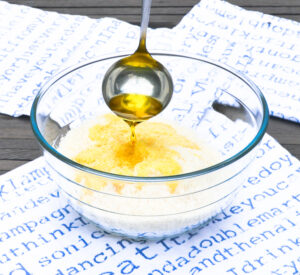
Melt the ghee over low heat and add to the grind kataifi.

Using your hands, mix together the shredded filo pastry with the ghee.
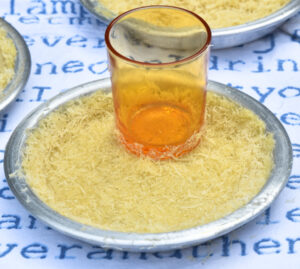
Grease the 6 round mini 12 cm/ 5 inches rimmed baking sheets with ghee, making sure to cover sides and bottom. Take a handful of the kadaifi and press it into the mini rimmed greased baking sheet and slightly up the sides. Use the bottom of a small flat cup. This will help keep an even thickness of the kadifi crust around the sides and base. The thickness should be about 2 cm. Repeat with the remaining baking sheets.
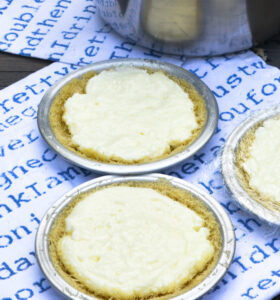
Add about 3 tablespoons of ashta (clotted cream) to each knafeh sheet to cover and level the surface.

Add the remaining shredded pastry to fully cover the ashta and press it gently with your hands to create a smooth connected surface.
Knafeh bil Ashta is a great make ahead dessert. At this stage knafeh bil ashta can sit in the fridge for 2 days before baking, which makes it a great candidate for entertaining. Make sure to cover with cling film to keep it from drying out. Remove the knafeh trays from the refrigerator 30 minutes before you intend to bake.
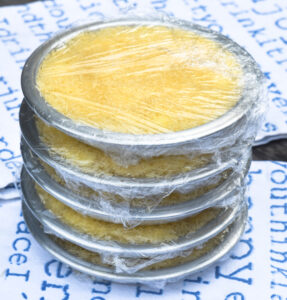
Equimpents needed
- 6 (12 cm) round rimmed mini aluminum oven baking sheets, I bought them specifically from Saida, Lebanon. For those who immediately tune out, rest assured you can assemble the knafeh bil ashta in a large round 30 cm /12 inches rimmed baking sheet, but please note that you it will require more time to bake through.
- A food processor, to separately grind the shredded phyllo dough/ knafeh strands/ kadaifi, and grind the pistachios.
- A whisk to make the ashta
- Two saucepans to make the sugar syrup and ashta
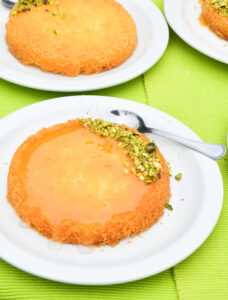
Hungry for more suagr syrup based Arabic sweets?

A Middle Eastern dinner almost always ends with a sweet bite, and this decadent knafeh bil ashta doubles as both a breakfast and dessert. It combines a crispy crust and a thick and unique decadent milk pudding drizzled with scented orange blossom water sugar syrup! Best eaten while warm! Divine
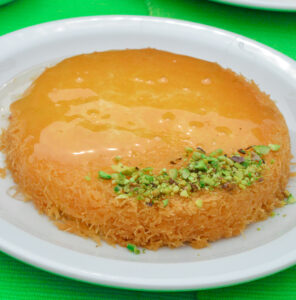
Ingredients:
- 500 g. /1lb. 2 oz. Kadayfi strands/kunafah strands/ shredded filo pastry
- 300 g. / 10.5 oz ghee, use a good brand
- A handful of raw shelled pistachios, for garnish
Ashta:
- 3 cups/ 750ml whole milk
- 1 cup / 250 ml heavy cream
- 4 heaped tablespoons cornstarch
- 2 tablespoons orange blossom water
- ¼ teaspoon mastic gum crushed with a pinch of sugar, optional but recommended
Sugar Syrup (Arabic Atter)
- 3 cups granulated sugar
- 11/2 cups water
- 2 tablespoons freshly squeezed lemon
- 2 tablespoons orange blossom water
Directions:
Prepare the sugar syrup:
- Place the sugar, water, and lemon juice in a saucepan over medium heat. Stir the mixture with a wooden spoon to dissolve. Once it boils reduce heat to low and simmer for 7 minutes. Do not cover the saucepan. Add the orange blossom water and simmer for 1 more minute. Set aside to completely cool down, this step can be made a few days before, kept in the fridge covered!
Prepare the Ashta:
- Place the milk, cornstarch and heavy cream in a saucepan over medium heat, whisking constantly until the mixture boils and totally thickens. It takes about 5 to 7 minutes. Add the crushed mastic, (if used) and orange blossom water, stir one more time to homogenize the mix. Place a piece of parchment paper on top to prevent a skin from forming. Set aside to cool down.
Grind the pistachios: roughly grind the pistachios with a food processor
To Put Together.
- Defrost the shredded filo pastry if frozen. Lightly pull the dough with your hands to separate into a loose pile. Add to a food processor, you may probably need to do that in batches, and pulse a few times to considerably grind them. Melt the ghee over low heat and infuse well together with the grind kadaifi.
- Grease the 6 round 12 cm/ 5 inches mini rimmed baking sheets with ghee, making sure to cover sides and bottom.
- Using your hands, mix together the shredded filo pastry with the ghee.
- Take a handful of the kadaifi and press it into the mini rimmed greased baking sheet and slightly up the sides. Use the bottom of a small flat cup. This will help keep an even thickness of the kadaifi crust around the sides and base. The thickness should be about 2 cm. Repeat with the remaining baking sheets.
- Add about 3 tablespoons ashta (clotted cream) to each knafeh sheet to cover and level the surface.
- Add the remaining shredded pastry to fully cover the ashta and press it gently with your hands to create a smooth connected surface
- Bake in a preheated oven, to 200°C/400°F, about 8 minutes or until the edges around the knafeh sheets turn golden and crisp.
- Remove from the oven, and loose the edges with a knife. Invert to a serving plate. The easiest way to flip your baked knafeh is to cover the baking pan with a pan with a larger baking sheet.
- Evenly drizzle with 2 tablespoons of sugar syrup to each knafeh sheet Drizzle some more sugar syrup upon serving and garnish with pistachios! Sublime!!

Thank you to all the readers who purchased “Hadia, Lebanese Style Recipes”. If you have a minute to spare, please rate and review the book on Amazon. We would like to know what you think! Here is the link to AMAZON
If you make the "Knafeh Bil Ashta", leave a comment below, or share your pictures on Facebook! I would love to see your creations!! Hashtag, #Hadia’s lebanese Cuisine

Subscribe to Our Newsletter
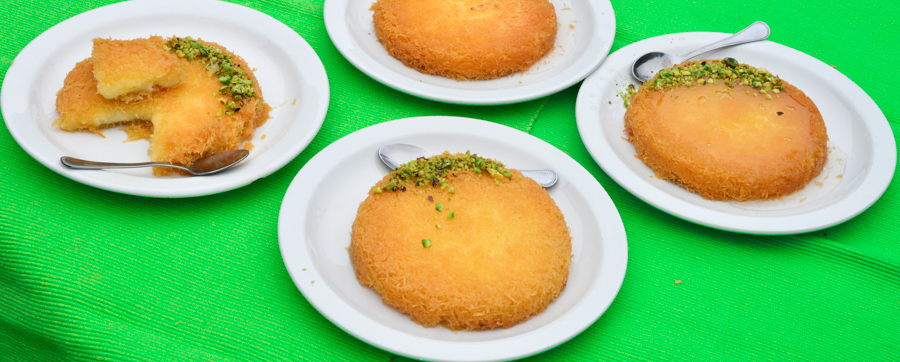
About Chef
Hadia Zebib
I am Hadia, the face behind Hadia’s Lebanese Cuisine. I grew up in Beirut Lebanon and I currently reside in Kinshasa, Congo with my husband and my three adorable sons, ...
Read more about this chef..

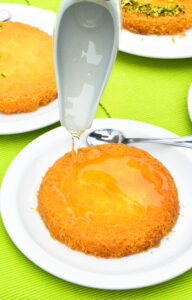


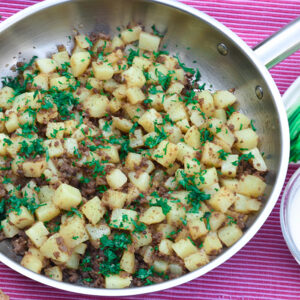
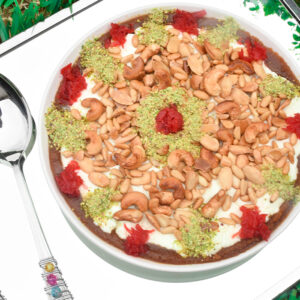

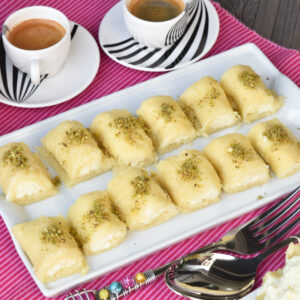
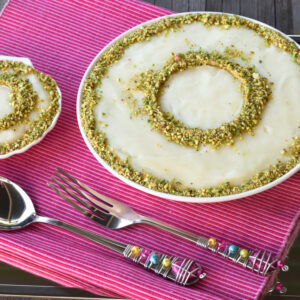
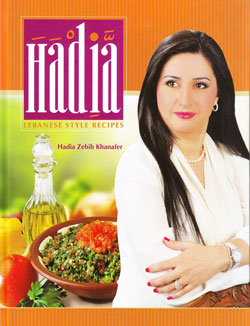
No comments yet.